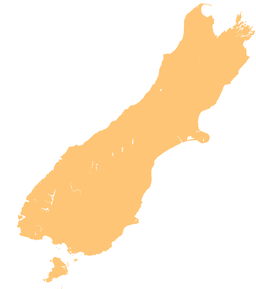Lake Hood is a man-made recreational lake, located 6 km south-east of Tinwald in the locality of Huntingdon, Canterbury, New Zealand. It was opened in 2001 by the Right Honourable Jenny Shipley. It is 2.3 km long by 1 km wide and is more than 80 hectares (0.80 km2) in area. It features an eight lane rowing course and separate waterskiing and jet skiing areas, and is home to Water Ski Lake Hood.[1] It is increasing in popularity for rowing, as it is not as susceptible to wind as the main South Island rowing venue, Lake Ruataniwha.[2]
| Lake Hood | |
|---|---|
 Lake Hood in 2012 | |
| Location | Canterbury, South Island |
| Coordinates | 43°58′04″S 171°46′18″E / 43.9678°S 171.7716°E |
| Type | artificial lake |
| Basin countries | New Zealand |
| Max. length | 2.3 km (1.4 mi) |
| Max. width | 1 km (0.62 mi) |
| Surface area | 80 hectares (0.80 km2) |
Housing subdivision
editA substantial housing subdivision, serving as a satellite suburb of Ashburton has been built surrounding the lake. The area is described as a rural settlement by Statistics New Zealand, and includes Huntingdon. It covers 1.65 km2 (0.64 sq mi)[3] and had an estimated population of 520 as of June 2024,[4] with a population density of 315 people per km2. The settlement is part of the larger Eiffelton statistical area.[5]
| Year | Pop. | ±% p.a. |
|---|---|---|
| 2006 | 72 | — |
| 2013 | 213 | +16.76% |
| 2018 | 384 | +12.51% |
| Source: [6] | ||
Before the 2023 census, Lake Hood had a larger boundary, covering 12.64 km2 (4.88 sq mi).[3] Using that boundary, Lake Hood had a population of 384 at the 2018 New Zealand census, an increase of 171 people (80.3%) since the 2013 census, and an increase of 312 people (433.3%) since the 2006 census. There were 135 households, comprising 186 males and 195 females, giving a sex ratio of 0.95 males per female, with 90 people (23.4%) aged under 15 years, 45 (11.7%) aged 15 to 29, 198 (51.6%) aged 30 to 64, and 51 (13.3%) aged 65 or older.
Ethnicities were 99.2% European/Pākehā, 4.7% Māori, 0.8% Asian, and 0.8% other ethnicities. People may identify with more than one ethnicity.
Although some people chose not to answer the census's question about religious affiliation, 42.2% had no religion, and 52.3% were Christian.
Of those at least 15 years old, 60 (20.4%) people had a bachelor's or higher degree, and 30 (10.2%) people had no formal qualifications. 123 people (41.8%) earned over $70,000 compared to 17.2% nationally. The employment status of those at least 15 was that 177 (60.2%) people were employed full-time, and 66 (22.4%) were part-time.[6]
References
edit- ^ "Water skiers set for big contests". Ashburton Guardian. 16 February 2012. Retrieved 3 March 2012.
- ^ "Lake Hood overrun with college rowing crews". Ashburton Guardian. 24 February 2012. Retrieved 3 March 2012.
- ^ a b "ArcGIS Web Application". statsnz.maps.arcgis.com. Retrieved 2 February 2024.
- ^ "Aotearoa Data Explorer". Statistics New Zealand. Retrieved 26 October 2024.
- ^ 2018 Census place summary: Eiffelton
- ^ a b "Statistical area 1 dataset for 2018 Census". Statistics New Zealand. March 2020. 7027103 and 7027105.
External links
edit- "The Lake". Archived from the original on 2007-02-10. Retrieved 2007-02-07.
- "Experience Mid Canterbury - Lake Hood". Retrieved 2012-04-16.
